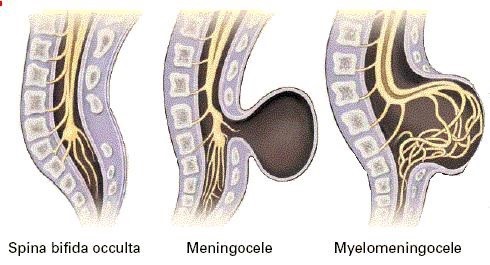Introduction
Spina Bifida is a congenital disease and is more common among children. The condition starts when the fetus’ meninges (surrounding lining) of the central nerve is not completely closed during pregnancy. The condition become serious when the meninges protruded from the lining.
 |
| Resource : www.doctortipster.com |
Spina Bifida Classification
- Spina Bifida Occulta
- No obvious protrusion and usually does not affect the daily function.
- Meningocele
- Cerebrospinal fluids (CSF) (liquid) of the central nerve come out and compress the skin. Obvious protrusion can been seen.
- Myelomeningocele
- The most severe condition but not common.
- Some of the nerve protrudes from the spinal canal and compress to the skin and causes limitation of movement, excitement and function.
- The condition becomes more serious when it occurs in the brain caused by the compression of accumulated CSF.
Causes
- Most of the causes are unknown
- Environment
- Genetic
Factor That Cause The Condition To Be Severe
- The size of the -protrusion and location
- Involvement of the skin that is being compressed
- Involvement of the spinal cord level that is being impinged
Objective Of Physiotherapy Management
- To strengthen the muscle
- To maintain/improve active joint movement
- To maintain optimum lower limb range and strength
- To improve joint sense and function
- To maintain optimum muscle length to prevent contracture
- To promote independent in daily activity
- To relieve pain (if necessary)
Signs / Symptoms
- Dimple on the affected location
- Hair growth on the affected location
- Inflammation along the affected spine
- Absent or impaired sensation on the affected limbs
- Unable or difficulty in limbs’ movement
- Crooked Spine (Scoliosis)
- Learning difficulties, fitting, vision problem among children with severe problems
Complication
- Physical and neurological problems
- Parts or total body paralysis with bowel problems
- Commonly for those who underwent the shunt procedure
- Difficult or unable to move the affected limbs
- Bladder incontinence
- Digestive system and voice production problems
- Skin problems
- Bowel problems
- Hydrocephalus (compression of the brain due to excessive CSF)
- Commonly ventricular shunt would be done on the babies with hydrocephalus. Excessive CSF will be drain out via a tube to the stomach
- Brain infectious disease eg Meningitis and Encephalitis
- Early maturity
- Psychological problems eg depression and low self esteem
Physiotherapy Treatment
Treatment can be given :
- Orthopedic Ambulatory supporting devices
- Walking aid and brace usually been prescribed depending on patients’ functional level
- Wheelchair
- Exercise: there are many exercises that are suitable for affected child to participate e.g strengthening exercises, hydrotherapy etc
Rehabilitation
- Children with Spina Bifida must achieve their gross motor according to the normal milestone as soon as possible eg sitting ability and crawling
- Children with Spina Bifida must undergo appropriate training eg hydrotherapy, upper and lower body conditioning etc
- Children with Spina Bifida must be trained to be independent in daily activity eg walking training using walking aids or locomotion skills such as advanced wheelchair skills eg wheelie
- Children with Spina Bifida must be prescribed with joint splint (if necessary) to prevent muscle contracture
- Children with Spina Bifida must be educated to protect their joint to prevent early arthritis caused by overexertion and overuse
Reference
- Bier JA, Prince A, Tremont M, Msall M. Medical, functional, and social determinants of health-related quality of life in individuals with myelomeningocele. Dev Med Child Neurol 2005; 47 (9):609-12.
- Fujisawa D, Gois M, Dias J, Alves E, Tavares M, Cardoso J. Intervening factors in the walking of children presenting myelomeningocele. Fisioter 2011;24:275-83.
- Verhoef M, Barf HA, Post MW, van Asbeck FW, Gooskens RH, Prevo AJ. Functional independence among young adults with spina bifida, in relation to hydrocephalus and level of lesion. Dev Med Child Neurol 2006;48(2):114-9.
| Last Reviewed | : | 23 August 2019 |
| Writer | : | Pauzillah binti Hj. Dollah |
| Translator | : | Naqiuddin bin Mohd Johar |
| Accreditor | : | Se To Phui Lin |
| Reviewer | : | Halimah bt. Hashim |







